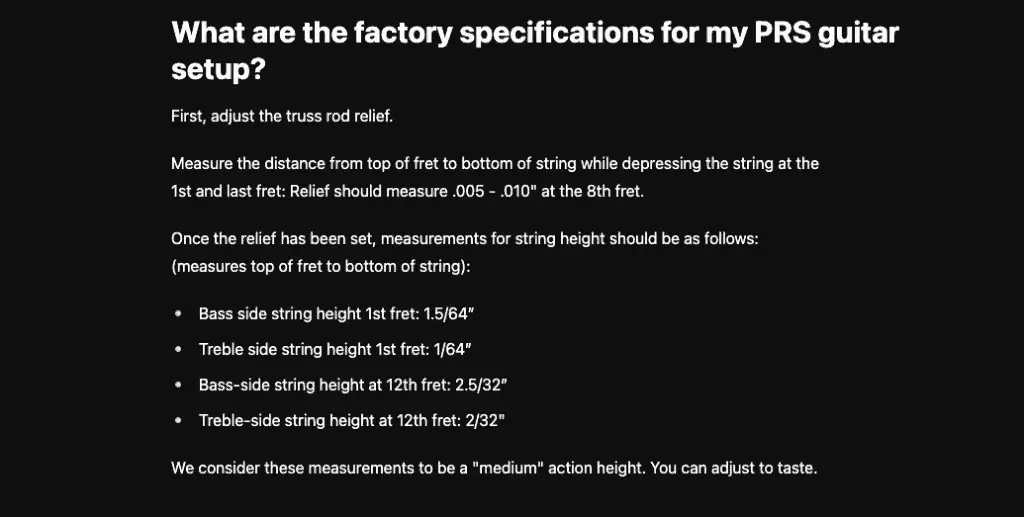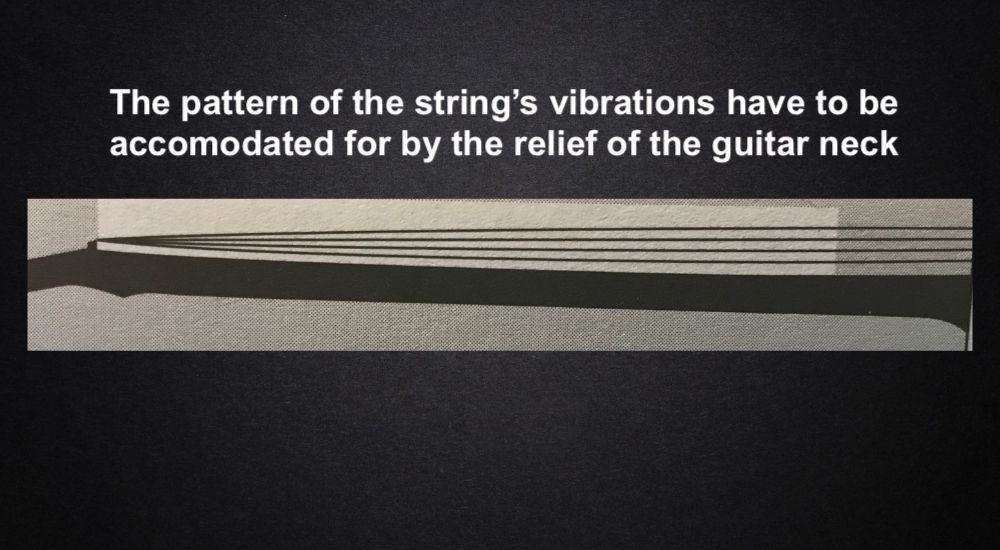When it comes to guitar setups, there are quite a few things to know and much of it can’t be remembered at the top of your head, especially if you’re only setting your guitar up a few times a year. Guitar technicians and luthiers have more of a handle on this kind of thing simply because they’re constantly setting up instruments, however, the average player does not.
That said, one of the more common questions about guitar set-ups has to do with the action: the term that describes how far away the strings are from the fretboard. We know that a low action is often desired over a high action, but should the strings be completely parallel to the fretboard?
Guitar strings shouldn’t be totally parallel to the fretboard even though they might look that way. Guitar necks have to be set up so there is a certain amount of convex curve, also called “relief,” that way the strings have enough space to vibrate.
Additionally, every guitar has a bridge of some kind, but what kind of bridge varies from model to model. A hardtail bridge, for example, is what you would see on a Fender Stratocaster whereas a Tune-O-Matic bridge is what you would see on a Gibson Les Paul. Despite the differences between the various bridges, the same principle holds true which is that the nut (where the strings sit between the neck and headstock) is lower than the bridge, at least in terms of where the strings sit. But let’s talk a little bit more about this.
Why Guitar Strings Shouldn’t Be Parallel to the Guitar Fretboard
1) The Nut Is Usually Lower Than The Bridge
There are a couple of reasons why the strings shouldn’t be parallel to the guitar fretboard. One is that the nut usually sits slightly lower than the bridge as we just discussed.
For example, on Paul Reed Smith’s factory specifications page (link here), they state that the string action measured at the nut should be 1.5/64″ on the Low-E side and 1/64″ on the High-E side.
Use Mituyoto’s 6″ ruler to make these measurements, it’s the one I use. In fact, you can read more about how to use this stuff in my guide on setting up a PRS guitar’s action.

Measuring the string height at the 12th fret will produce higher numbers like 2.5/32″ and 2/32″ because the string action has to accommodate the vibrations.
In other words, where the strings sit in the bridge must be higher than the nut, otherwise, the guitar will produce out-of-control buzzing.
The other reason why strings shouldn’t be totally parallel is that they’re not equally far apart from the fretboard. It depends on the thickness of the lower and higher strings (Dan Erlewine’s guitar repair guide from Amazon is a great resource for such information).
2) The Higher Strings Are Usually Closer to the Fretboard Than The Lower Strings
It’s not uncommon for luthiers and guitar technicians to set up their instruments in such a way where the higher strings, E, B, and G, are closer to the fretboard than the lower strings E, A, and D. I touched on this here as well.
The reason for this has to do with the way the guitar strings vibrate as well as the relative thickness of each string.
The lowest strings have to be much thicker so they can produce a lower sound. This also means there needs to be more space between the fretboard and the strings that way they have enough to vibrate without causing fret buzz.
Because of this simple fact, it means the strings usually can’t be parallel to the fretboard.
3) The Neck Should Have A Convex Curve to Create Space for Vibrating Strings
The other reason has to do with what we already talked about. Note the difference between a convex curve and a concave curve.
A concave curve is where the middle of the curve is protruding upward, this would be a back bow, whereas a convex curve is where the curve in the middle is going downward.

If we think about how the guitar strings vibrate, there needs to be enough space in the middle – between where the string sits in the nut and the bridge – for the strings to vibrate. This is just physics.
The string can’t oscillate back and forth quickly where it’s being tightly held at the nut and the bridge so that force has to be in the center where it’s unobstructed.

What Should Be The Distance Between the Strings and Fretboard?
The distance between the fretboard and the strings varies from guitar to guitar and from manufacturer to manufacturer.
That said, most companies – including PRS whose SE Custom 24 I own – have a specifications list on their website or somewhere else where they tell people what the factory specifications are, like the string action, the relief, and similar measurements.
A standard distance between the guitar strings and guitar fretboard at the 12th fret is 2/32″ on the High-E side and 2.5/32″ on the Low-E string side with the relief at 0.007″ approximately. You may also see these specifications as 64ths instead, for example, “4/64″ and 5/64”.
Like we’ve said already in this article and in my guide on how to set up a PRS from scratch, this measurement varies on the instrument as well as the player’s preferences, but the aforementioned measurements are a good rule of thumb to go by. The playing style matters for this kind of thing too.
For example, if you tune your guitar much lower, you’ll need thicker strings to accommodate for that, and you’ll likely need slightly more relief to accommodate for the string’s vibration path. Another variable is how hard a player’s attack is.
If you’re the type of player who likes to pick really hard and fret really hard, you’ll probably need more relief or a slightly higher action to deal with that.
How Do I Know If My Action Is Too High?
The best way to tell if your action is too high is to ask yourself if you actually enjoy playing the guitar. The action height is up to the player to decide, so if you feel like it’s too difficult to play, it’s probably too high. You may also run into intonation issues.
In fact, intonation problems are one of the reasons why having a high action is typically a bad idea, other than the fact that the guitar will be incredibly difficult to play. The reason for this has to do with the length of the string between the point of pressure and the bridge and nut.
Most guitar luthiers and technicians state that guitarists like to have low action. A common request for guitar technicians to set up their instrument is to ask for the “lowest possible action without buzzing,” even though there will always be a reasonable amount of fret buzz.
A useful video on this topic can be found on YouTube on Rhett Shull’s channel where he speaks with a shop owner in Nashville, Tennessee.
Like the shop owner says in the video, expecting a super low action without some degree of fret buzz is just unreasonable because the strings have to vibrate in order to make a sound.
There has to be some kind of trade-off between fret buzz and playability because of the nature of vibration and how steel strings produce sound.
Important Things to Note About Guitar Setups
1) Nothing Is A Rule – It’s A Guideline
When it comes to guitar set-ups, most will argue that there are just rules of thumb rather than set-in-stone rules. While there are certainly some people who will say there is a correct amount of relief, another technician with equal experience will say there isn’t.
That said, these guidelines and standards of practice are a great way to figure things out for yourself.

 Written By :
Written By :